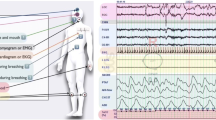Abstract
To explore the risk of obstructive sleep apnea (OSA) in patients with primary muscle tension dysphonia (MTD). The medical records of patients diagnosed with primary MTD between November 2021 and March 2023, were reviewed. The risk of having OSA was assessed by looking at the scores of two validated questionnaires, namely the STOP-BANG questionnaire and the Berlin questionnaire. A total of 40 patients with primary MTD were enrolled in this study, including 16 females (40%) and 24 males (60%). The mean total STOP-BANG score was 3.57 ± 1.67. Seventeen of the study group had intermediate risk of OSA, and 14 had high risk, accounting for 77.5% of patients with primary MTD. When using the Berlin questionnaire, the mean total score was 1.65 ± 0.95, and 67.5% of the study group had a score > 2 and were at high risk of having OSA. The results of this study indicate that patients with primary MTD are at moderate to severe risk of having OSA.
Similar content being viewed by others
References
Van Houtte E, Van Lierde K, Claeys S (2011) Pathophysiology and treatment of muscle tension dysphonia: a review of the current knowledge. J Voice 25:202–207. https://doi.org/10.1016/j.jvoice.2009.10.009
Koufman JA, Blalock PD (1982) Classification and approach to patients with functional voice disorders. Ann Otol Rhinol Laryngol 91:372–377. https://doi.org/10.1177/000348948209100409
Verdolini K, Rosen CA, Branski RC (2014) Classification manual for voice disorders-I. Psychology, London
Koufman JA, Amin MR, Panetti M (2000) Prevalence of reflux in 113 consecutive patients with laryngeal and voice disorders. Otolaryngol Head Neck Surg 123:385–388. https://doi.org/10.1067/mhn.2000.109935
Vertigan AE, Kapela SL, Gibson PG (2021) Laryngeal dysfunction in severe asthma: a cross-sectional observational study. J Allergy Clin Immunol Pract 9:897–905. https://doi.org/10.1016/j.jaip.2020.09.034
Lee JJ, Sundar KM (2021) Evaluation and management of adults with obstructive sleep apnea syndrome. Lung 199:87–101. https://doi.org/10.1007/s00408-021-00426-w
Rosen CA, Lee AS, Osborne J, Zullo T, Murry T (2004) Development and validation of the voice handicap index-10. Laryngoscope 114:1549–1556. https://doi.org/10.1097/00005537-200409000-00009
Chung F, Abdullah HR, Liao P (2016) STOP-Bang Questionnaire: a practical Approach to screen for obstructive sleep apnea. Chest 149:631–638. https://doi.org/10.1378/chest.15-0903
Chung F, Yegneswaran B, Liao P, Chung SA, Vairavanathan S, Islam S, Khajehdehi A, Shapiro CM (2008) Validation of the Berlin questionnaire and American Society of Anesthesiologists checklist as screening tools for obstructive sleep apnea in surgical patients. Anesthesiology 108:822–830. https://doi.org/10.1097/ALN.0b013e31816d91b5
Lurie A (2011) Obstructive sleep apnea in adults: epidemiology, clinical presentation, and treatment options. In: Lurie A (ed) Obstructive sleep apnea in adults. Karger, Switzerland, pp 1–42
Nguyen AT, Jobin V, Payne R, Beauregard J, Naor N, Kimoff RJ (2005) Laryngeal and velopharyngeal sensory impairment in obstructive sleep apnea. Sleep 28:585–593. https://doi.org/10.1093/sleep/28.5.585
Netzer NC, Stoohs RA, Netzer CM, Clark K, Strohl KP (1999) Using the Berlin Questionnaire to identify patients at risk for the sleep apnea syndrome. Ann Intern Med 131:485–491. https://doi.org/10.7326/0003-4819-131-7-199910050-00002
Chung F, Subramanyam R, Liao P, Sasaki E, Shapiro C, Sun Y (2012) High STOP-Bang score indicates a high probability of obstructive sleep apnoea. Br J Anaesth 108:768–775. https://doi.org/10.1093/bja/aes022
Sharma SK, Kumpawat S, Banga A, Goel A (2006) Prevalence and risk factors of obstructive sleep apnea syndrome in a population of Delhi, India. Chest 130:149–156. https://doi.org/10.1378/chest.130.1.149
Deegan PC, McNicholas WT (1996) Predictive value of clinical features for the obstructive sleep apnoea syndrome. Eur Respir J 9:117–124. https://doi.org/10.1183/09031936.96.09010117
Sarıman N, Koca Ö, Boyacı Z, Levent E, Soylu AC, Alparslan S, Saygı A (2012) Microscopic bilateral posterior cordotomy in severe obstructive sleep apnea syndrome with bilateral vocal cord paralysis. Sleep Breath 16:17–22. https://doi.org/10.1007/s11325-010-0458-9
Hamdan AL, Khalifee E, Abi Akl PR, Ghanem A, El Hage A (2020) Pathogenic role of Reinke’s Edema in Snoring and Obstructive Sleep Apnea. J Voice 34:456–459. https://doi.org/10.1016/j.jvoice.2018.12.001
Redenbaugh MA, Reich AR (1989) Surface EMG and related measures in normal and vocally hyperfunctional speakers. J Speech Hear Disord 54:68–73. https://doi.org/10.1044/jshd.5401.68
Hocevar-Boltezar I, Janko M, Zargi M (1998) Role of surface EMG in diagnostics and treatment of muscle tension dysphonia. Acta Otolaryngol 118:739–743. https://doi.org/10.1080/00016489850183287
Mansuri B, Torabinezhad F, Jamshidi AA, Dabirmoghadam P, Vasaghi-Gharamaleki B, Ghelichi L (2019) Effects of Voice Therapy on vocal tract discomfort in muscle tension Dysphonia. Iran J Otorhinolaryngol 31:297–304
Nandwani N, Caranza R, Hanning CD (1998) Obstructive sleep apnoea and upper airway reactivity. J Sleep Res 7:115–118. https://doi.org/10.1046/j.1365-2869.1998.00096.x
Acknowledgements
Not applicable.
Funding
The authors did not receive support from any organization for the submitted work.
Author information
Authors and Affiliations
Contributions
Abdul-Latif Hamdan: study idea and coordination with manuscript editing and writing. Christophe Abi Zeid Daou: data analysis, data filtering, and write-up. Anthony Ghanem and Randa Barazi: write-up and data collection. Charbel Fadel, Jad Hosri, and Batoul Jaber: data collection and manuscript revision. Elie Alam: data collection, patient recruitment, and manuscript submission.
Corresponding author
Ethics declarations
Ethical Approval
This study was performed in line with the principles of the Declaration of Helsinki. Approval was granted by the Ethics Committee of the American University of Beirut (IRB ID: BIO-2022-0165).
Consent to Participants
Due to the retrospective nature of the study, informed consent was not obtained from the participants.
Conflict of Interest
The authors have no relevant financial or non-financial interests to disclose.
Additional information
Publisher’s Note
Springer Nature remains neutral with regard to jurisdictional claims in published maps and institutional affiliations.
Rights and permissions
Springer Nature or its licensor (e.g. a society or other partner) holds exclusive rights to this article under a publishing agreement with the author(s) or other rightsholder(s); author self-archiving of the accepted manuscript version of this article is solely governed by the terms of such publishing agreement and applicable law.
About this article
Cite this article
Hamdan, AL., Abi Zeid Daou, C., Hosri, J. et al. The Risk of Obstructive Sleep Apnea in Patients with Primary Muscle Tension Dysphonia. Indian J Otolaryngol Head Neck Surg (2024). https://doi.org/10.1007/s12070-024-04746-0
Received:
Accepted:
Published:
DOI: https://doi.org/10.1007/s12070-024-04746-0




